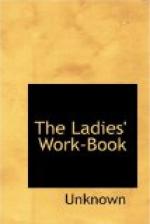The marks used in crochet receipts.—These are very simple when understood. They are printers’ marks—asterisks, crosses, daggers, and sometimes one or two others. They are used to mark repetitions, and save space. The principal thing to observe is, that in every row or round, if one of any kind is used, a second, similar one, is sure to be found; and that the repetition occurs between the two, however far distant apart. Suppose a row of a pattern to be written thus:—X 2 d.c., 4 ch., miss 4, * 5 d.c., 1 ch., miss 1, * three times, 5 d.c., X, * twice; it would, at full length, be—2 d.c., 4 ch., miss 4, 5 d.c., 1 ch., miss 1, 5 d.c., 1 ch., miss 1, 5 d.c., 1 ch., miss 1, 5 d.c., 2 d.c., 4 ch., miss 4, 5 d.c., 1 ch., miss 1, 5 d.c., 1 ch., miss 1, 5 d.c., 1 ch., miss 1, 5 d.c. It will be seen that one repetition often occurs within another, as in the stitches between the asterisks. Another mode of shortening receipts can be used only where a row has a centre both sides of which correspond; the latter being the same as the former, worked backwards. Then the letters b, a, are used, to mark that in the latter part of the row you reverse the instructions. b, 7 d.c., 3 ch., miss 2, 1 d.c., 2 ch., miss 1, a, 1 d.c. (the centre stitch), would be, 7 d.c., 3 ch., miss 2, 1 d.c., 2 ch., miss 1, 1 d.c., miss 1, 2 ch., 1 d.c., miss 2, 3 ch., 7 d.c. These letters and the printers’ marks are equally used in knitting. It is easy to see how much space is gained by the use of these abbreviations, a knowledge of which is easily acquired. Probably many of our friends are already familiar with the substance of this preliminary lesson; but as daily experience convinces us that many are still ignorant of the principles of crochet, we trust the good-nature of the adepts will lead them to excuse this occupation of a page, in consideration of the benefit it will be to their less fortunate friends.
One word on the implement termed a crochet-hook. It should not be sharp or pointed, either in the point or barb, but smooth, and quite free from any angularity that can catch the silk. Cheap and common crochet-hooks are in the end the dearest, as they break cotton, ravel silk, wear out the patience, and prick the finger. They should be of the best steel, highly polished, and firmly fixed in ivory handles. Those we use have been made at our recommendation, and have the size engraved on every handle. This saves the tiresome and uncertain reference to a gauge. These hooks are termed “tapered, indented” crochet-hooks.
* * * * *
ANTI-MACASSAR.
MATERIALS.—Four reels of Brooks’ Great Exhibition Prize Goat’s-head Crochet Cotton, No. 8, 1 ditto, No. 4, 4 ounces of turquoise blue beads.




